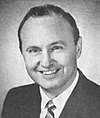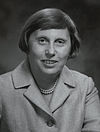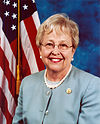Ohio's 19th congressional district was created following the 1830 census and was eliminated after the 2000 census. Between 1863 and 1880, it was represented by future US President James A. Garfield, who became the only sitting House member ever to be elected to the Presidency.
The 20th congressional district of Ohio was created after the 1840 census. It was eliminated in the redistricting following the 1990 census, and redistricted and renumbered as the 10th district.
The 21st congressional district of Ohio was a congressional district in the state of Ohio. It was eliminated in the redistricting following the 1990 census.
Ohio's at-large congressional district existed from 1803 to 1813, from 1913 to 1915, from 1933 to 1953 and from 1963 until 1967, when it was banned by the Voting Rights Act of 1965.
Nebraska's 5th congressional district is an obsolete district. It was created after the 1890 United States census and eliminated after the 1940 United States census.
New Jersey's 14th congressional district in the House of Representatives was eliminated after the 1990 Census. As a result of the congressional apportionment performed after this Census, New Jersey lost one seat and was reduced to thirteen seats in the House of Representatives.
New York's 34th congressional district was a congressional district for the United States House of Representatives in New York. It was created in 1843 as a result of the 1840 Census, eliminated after the 1850 Census, and then re-created in 1885 due to the 1880 Census. It was eliminated most recently as a result of the 1990 Census. It was last represented by Amo Houghton who was redistricted into the 31st District.
The 40th congressional district of New York was a congressional district for the United States House of Representatives in New York. It was created in 1913 as a result of the 1910 Census. It was eliminated in 1973 as a result of the 1970 redistricting cycle after the 1970 United States census.. It was last represented by Henry P. Smith III who was redistricted into the 36th District.
The 41st congressional district of New York was a congressional district for the United States House of Representatives in New York. It was created in 1913 as a result of the 1910 Census. It was eliminated in 1973 as a result of the 1970 redistricting cycle after the 1970 United States census. It was last represented by Thaddeus J. Dulski who was redistricted into the 37th District.
The 42nd congressional district of New York was a congressional district for the United States House of Representatives in New York. It was created in 1913 as a result of the 1910 Census. It was eliminated as a result of the 1960 Census. It was last represented by John R. Pillion, who was redistricted into the 39th District.
The 44th congressional district of New York was a congressional district for the United States House of Representatives in New York. It was created in 1945. It was eliminated as a result of the 1950 Census. It was last represented by John C. Butler.
New Jersey's 15th congressional district in the House of Representatives was a relatively short-lived district that was created after the 1960 Census and eliminated as a result of the redistricting cycle after the 1980 Census.
Maine's 7th congressional district is an obsolete congressional district in the U.S. state of Maine. It was created in 1821 after Maine was admitted to the Union in 1820. The district was eliminated in 1853 following the 1850 census. Its last congressman was Thomas Fuller.
Vermont's 2nd congressional district is an obsolete district. It was created upon Vermont's admission as the 14th State in 1791. It was eliminated after the 1930 Census. Its last Congressman was Ernest W. Gibson, who was redistricted into the At-large district.
Virginia's 14th congressional district is an obsolete congressional district. It was eliminated in 1853 after the 1850 U.S. census. Its last congressman was James M. H. Beale.
Virginia's 16th congressional district is an obsolete congressional district. It was eliminated in 1843 after the 1840 U.S. census. Its last congressman was William A. Harris.
Virginia's 21st congressional district is an obsolete congressional district. It was eliminated in 1843 after the 1840 U.S. census. Its last congressman was Lewis Steenrod.
Indiana's 11th congressional district was a congressional district for the United States House of Representatives in Indiana. In its final configuration, it covered most of the southern portion of Indianapolis. It was eliminated as a result of the redistricting cycle after the 1980 census.
Indiana's 12th congressional district was a congressional district for the United States House of Representatives in Indiana. It was eliminated as a result of the 1940 census. It was last represented by Louis Ludlow who was redistricted into the 11th district.
Indiana's 13th congressional district was a congressional district for the United States House of Representatives in Indiana. It was eliminated as a result of the 1930 census. It was last represented by Samuel B. Pettengill who was redistricted into the 3rd district.





